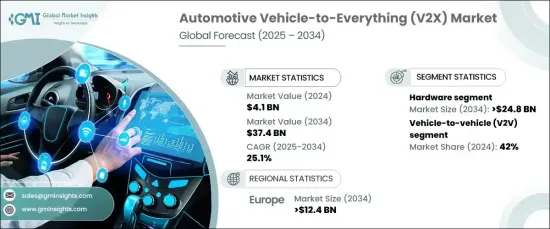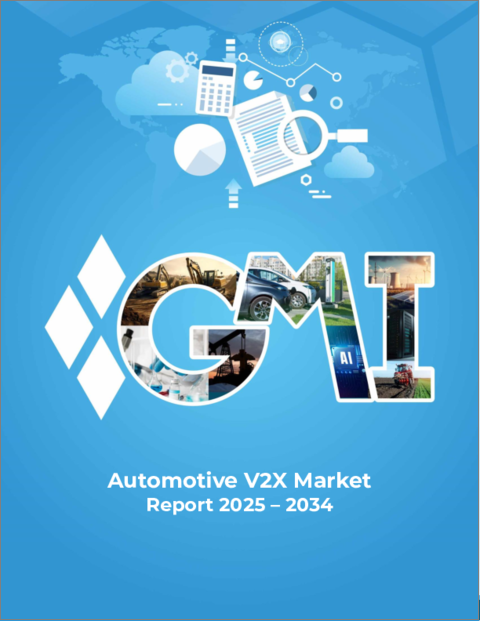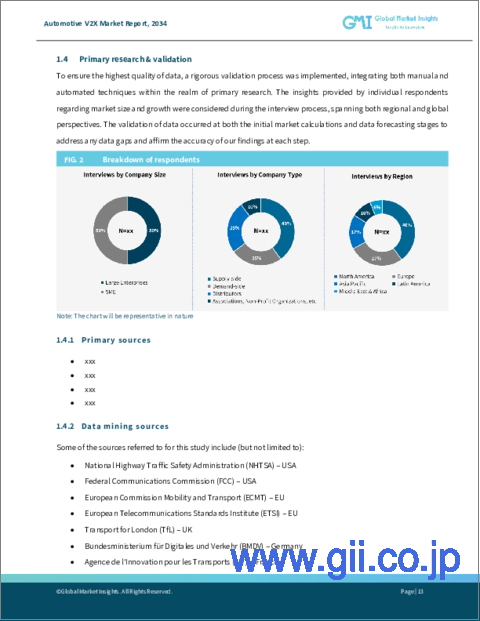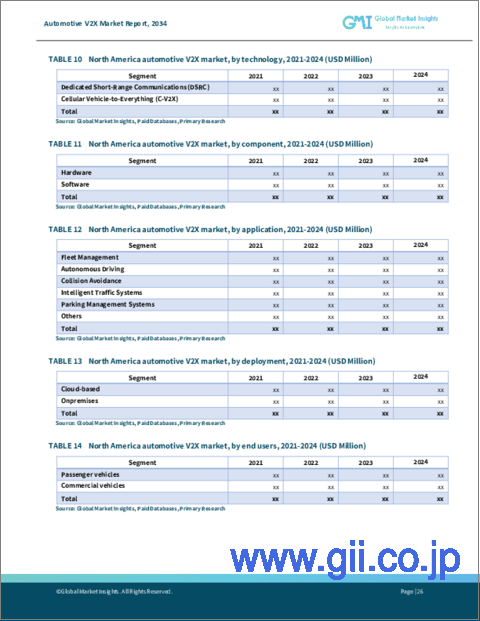|
|
市場調査レポート
商品コード
1666604
自動車V2Xの市場機会、成長促進要因、産業動向分析、2025年~2034年予測Automotive Vehicle-To-Everything (V2X) Market Opportunity, Growth Drivers, Industry Trend Analysis, and Forecast 2025 - 2034 |
||||||
カスタマイズ可能
|
|||||||
| 自動車V2Xの市場機会、成長促進要因、産業動向分析、2025年~2034年予測 |
|
出版日: 2024年12月06日
発行: Global Market Insights Inc.
ページ情報: 英文 180 Pages
納期: 2~3営業日
|
全表示
- 概要
- 目次
世界の自動車V2X市場は2024年に41億米ドルに達し、2025年から2034年のCAGRは25.1%と予測されています。
この成長の主因は、交通安全強化のニーズの高まりと、自律走行技術の進歩にあります。各国政府が交通安全基準の厳格化とスマート交通システムの開発を推進する中、コネクテッド・ビークル・システムの統合が広まりつつあります。車両、インフラ、歩行者間のリアルタイム通信を可能にする5Gネットワークの展開も、交通効率、安全性、都市モビリティの向上に重要な役割を果たしています。

スマートシティの台頭と都市インフラの変革の進行は、コネクテッド・ビークル・テクノロジーの採用をさらに加速させています。持続可能な交通ソリューションへのニーズは、都市化の進展と相まって、インテリジェント交通管理システム、電気自動車(EV)充電ステーション、V2X対応インフラへの投資を促進しています。これらの技術革新は、よりスムーズな交通の流れを作り出し、排出ガスを削減し、公共の安全を強化することを目的としており、市場全体の成長に寄与しています。
| 市場範囲 | |
|---|---|
| 開始年 | 2024年 |
| 予測年 | 2025年~2034年 |
| 開始金額 | 41億米ドル |
| 予測金額 | 374億米ドル |
| CAGR | 25.1% |
市場はコンポーネント別にハードウェアとソフトウェアに分類され、2024年の市場シェアはハードウェアが64%を占めました。ハードウェアセグメントは大幅に成長し、2034年まで248億米ドルを創出すると予測されます。高性能センサー、アンテナ、車載ユニットといったハードウェアの主な進歩により、車両とインフラ間のリアルタイム通信に必要な接続性とデータ処理能力が強化されています。マルチバンドアンテナやエッジコンピューティング技術の導入により、より効率的なデータ交換が推進される一方、チップセットやモジュールのコスト削減により、乗用車と商用車の両方でこれらのソリューションが利用しやすくなっています。
V2X市場の通信技術も進化しており、車車間(V2V)、車車間インフラ(V2I)、車車間歩行者(V2P)などのセグメントがあります。なかでもV2V通信が最大のシェアを占め、2024年には市場の42%を占めました。5GやC-V2Xのような低遅延通信技術の開発がV2Vシステムの採用を加速しており、衝突回避や協調運転のようなタスクのためのリアルタイムデータ共有が容易になっています。これらの技術は、より安全で効率的な道路を実現するための土台を築き、最終的には完全自律走行車へのシフトをサポートします。
欧州の自動車車間通信(V2X)市場は2024年に34%のシェアを占めました。この地域は、先進的な自動車部門とインテリジェント交通システムに対する政府の強力な支援により、著しい成長を遂げています。5Gインフラと自律走行技術への投資が市場拡大をさらに促進し、欧州をコネクテッド・モビリティへの世界的シフトにおける主要プレーヤーとして位置付けています。
目次
第1章 調査手法と調査範囲
- 調査デザイン
- 調査アプローチ
- データ収集方法
- 基本推定と計算
- 基準年の算出
- 市場推計の主要動向
- 予測モデル
- 一次調査と検証
- 一次ソース
- データマイニングソース
- 市場定義
第2章 エグゼクティブサマリー
第3章 業界洞察
- エコシステム分析
- サプライヤーの状況
- 原材料プロバイダー
- 技術プロバイダー
- ソフトウェアプロバイダー
- システムインテグレーター
- OEM
- 通信プロバイダー
- 最終用途
- 利益率分析
- 技術とイノベーションの展望
- 特許分析
- 主要ニュースとイニシアチブ
- 規制状況
- 技術の差別化要因
- 通信プロトコル
- AIと機械学習の統合
- サイバーセキュリティ
- 影響要因
- 成長促進要因
- 超高信頼性接続を可能にする5Gの進歩
- V2Xの採用を推進する政府の安全義務化
- スマートシティ開発を推進する都市化の進展
- 自律走行車と電気自動車の急成長
- 業界の潜在的リスク・課題
- 普及を遅らせるインフラコストの高さ
- データと車両の安全を脅かすサイバーセキュリティの脆弱性
- 成長促進要因
- 成長可能性分析
- ポーター分析
- PESTEL分析
第4章 競合情勢
- イントロダクション
- 企業市場シェア分析
- 競合のポジショニングマトリックス
- 戦略展望マトリックス
第5章 市場推計・予測:コネクティビティ別、2021年~2034年
- 主要動向
- 専用近距離通信(DSRC)
- セルラー車車間通信(C-V2X)
第6章 市場推計・予測:車両別、2021年~2034年
- 主要動向
- 乗用車
- セダン
- SUV
- ハッチバック
- その他
- 商用車
- 小型商用車(LCV)
- 大型商用車(HCV)
第7章 市場推計・予測:通信別、2021年~2034年
- 主要動向
- 車両間通信(V2V)
- 車車間(V2I)
- 車両対歩行者(V2P)
- その他
第8章 市場推計・予測:コンポーネント別、2021年~2034年
- 主要動向
- ハードウェア
- ソフトウェア
第9章 市場推計・予測:用途別、2021年~2034年
- 主要動向
- フリート管理
- 自律走行
- 衝突回避
- インテリジェント交通システム
- 駐車場管理システム
- その他
第10章 市場推計・予測:地域別、2021年~2034年
- 主要動向
- 北米
- 米国
- カナダ
- 欧州
- 英国
- ドイツ
- フランス
- スペイン
- イタリア
- ロシア
- 北欧
- アジア太平洋
- 中国
- インド
- 日本
- 韓国
- ニュージーランド
- 東南アジア
- ラテンアメリカ
- ブラジル
- メキシコ
- アルゼンチン
- 中東・アフリカ
- UAE
- 南アフリカ
- サウジアラビア
第11章 企業プロファイル
- Aptiv
- Autotalks
- Bosch
- Cohda Wireless
- Commsignia
- Continental
- Denso
- Ficosa
- Harman
- Huawei
- Infineon
- Kapsch TrafficCom
- NXP Semiconductors
- Qualcomm
- Visteon
The Global Automotive V2X Market reached USD 4.1 billion in 2024 and is projected to experience a CAGR of 25.1% during 2025-2034. This growth is primarily driven by the increasing need for enhanced road safety and the ongoing advancements in autonomous driving technologies. As governments push for stricter traffic safety standards and the development of smart transportation systems, the integration of connected vehicle systems is becoming more widespread. The rollout of 5G networks, enabling real-time communication between vehicles, infrastructure, and pedestrians, is also playing a crucial role in improving traffic efficiency, safety, and urban mobility.

The rise of smart cities and the ongoing transformation of urban infrastructure are further accelerating the adoption of connected vehicle technologies. The need for sustainable transportation solutions, coupled with the growing trend of urbanization, is driving investments in intelligent traffic management systems, electric vehicle (EV) charging stations, and V2X-enabled infrastructure. These innovations aim to create smoother traffic flows, reduce emissions, and enhance public safety, contributing to the overall growth of the market.
| Market Scope | |
|---|---|
| Start Year | 2024 |
| Forecast Year | 2025-2034 |
| Start Value | $4.1 Billion |
| Forecast Value | $37.4 Billion |
| CAGR | 25.1% |
The market is categorized by component into hardware and software, with hardware accounting for 64% of the market share in 2024. The hardware segment is projected to grow substantially, generating USD 24.8 billion through 2034. Key advancements in hardware, such as high-performance sensors, antennas, and onboard units, are enhancing the connectivity and data processing capabilities necessary for real-time communication between vehicles and infrastructure. The incorporation of multi-band antennas and edge computing technologies is driving more efficient data exchange, while cost reductions in chipsets and modules are making these solutions more accessible for both passenger and commercial vehicles.
Communication technologies within the V2X market are also evolving, with segments such as vehicle-to-vehicle (V2V), vehicle-to-infrastructure (V2I), vehicle-to-pedestrian (V2P), and others. Among these, V2V communication holds the largest share, accounting for 42% of the market in 2024. The development of low-latency communication technologies like 5G and C-V2X is accelerating the adoption of V2V systems, facilitating real-time data sharing for tasks like collision avoidance and cooperative driving. These technologies are laying the groundwork for safer, more efficient roads, ultimately supporting the shift toward fully autonomous vehicle operations.
Europe automotive vehicle-to-everything (V2X) market accounted for a 34% share in 2024. This region is seeing significant growth due to its advanced automotive sector and strong governmental support for intelligent transportation systems. Investments in 5G infrastructure and autonomous driving technologies are further driving market expansion, positioning Europe as a key player in the global shift towards connected mobility.
Table of Contents
Chapter 1 Methodology & Scope
- 1.1 Research design
- 1.1.1 Research approach
- 1.1.2 Data collection methods
- 1.2 Base estimates and calculations
- 1.2.1 Base year calculation
- 1.2.2 Key trends for market estimates
- 1.3 Forecast model
- 1.4 Primary research & validation
- 1.4.1 Primary sources
- 1.4.2 Data mining sources
- 1.5 Market definition
Chapter 2 Executive Summary
- 2.1 Industry 360º synopsis, 2021 - 2034
Chapter 3 Industry Insights
- 3.1 Industry ecosystem analysis
- 3.2 Supplier landscape
- 3.2.1 Raw material providers
- 3.2.2 Technology providers
- 3.2.3 Software providers
- 3.2.4 System integrators
- 3.2.5 OEM
- 3.2.6 Telecommunication providers
- 3.2.7 End Use
- 3.3 Profit margin analysis
- 3.4 Technology & innovation landscape
- 3.5 Patent analysis
- 3.6 Key news & initiatives
- 3.7 Regulatory landscape
- 3.8 Technology Differentiators
- 3.8.1 Communication Protocols
- 3.8.2 AI and Machine Learning Integration
- 3.8.3 Cybersecurity
- 3.9 Impact forces
- 3.9.1 Growth drivers
- 3.9.1.1 Advancement of 5G enabling ultra-reliable connectivity
- 3.9.1.2 Government safety mandates pushing V2X adoption
- 3.9.1.3 Increasing urbanization driving smart city development
- 3.9.1.4 Rapid growth of autonomous and electric vehicles
- 3.9.2 Industry pitfalls & challenges
- 3.9.2.1 High infrastructure costs slowing widespread deployment
- 3.9.2.2 Cybersecurity vulnerabilities risk data and vehicle safety
- 3.9.1 Growth drivers
- 3.10 Growth potential analysis
- 3.11 Porter’s analysis
- 3.12 PESTEL analysis
Chapter 4 Competitive Landscape, 2024
- 4.1 Introduction
- 4.2 Company market share analysis
- 4.3 Competitive positioning matrix
- 4.4 Strategic outlook matrix
Chapter 5 Market Estimates & Forecast, By Connectivity, 2021 - 2034 ($Bn)
- 5.1 Key trends
- 5.2 Dedicated short-range communications (DSRC)
- 5.3 Cellular vehicle-to-everything (C-V2X)
Chapter 6 Market Estimates & Forecast, By Vehicle, 2021 - 2034 ($Bn)
- 6.1 Key trends
- 6.2 Passenger vehicle
- 6.2.1 Sedan
- 6.2.2 SUV
- 6.2.3 Hatchback
- 6.2.4 Others
- 6.3 Commercial vehicle
- 6.3.1 Light Commercial Vehicle (LCV)
- 6.3.2 Heavy Commercial Vehicle (HCV)
Chapter 7 Market Estimates & Forecast, By Communication, 2021 - 2034 ($Bn)
- 7.1 Key trends
- 7.2 Vehicle-to-vehicle (V2V)
- 7.3 Vehicle-to-infrastructure (V2I)
- 7.4 Vehicle-to-pedestrian (V2P)
- 7.5 Others
Chapter 8 Market Estimates & Forecast, By Component, 2021 - 2034 ($Bn)
- 8.1 Key trends
- 8.2 Hardware
- 8.3 Software
Chapter 9 Market Estimates & Forecast, By Application, 2021 - 2034 ($Bn)
- 9.1 Key trends
- 9.2 Fleet management
- 9.3 Autonomous driving
- 9.4 Collision avoidance
- 9.5 Intelligent traffic system
- 9.6 Parking management systems
- 9.7 Others
Chapter 10 Market Estimates & Forecast, By Region, 2021 - 2034 ($Bn)
- 10.1 Key trends
- 10.2 North America
- 10.2.1 U.S.
- 10.2.2 Canada
- 10.3 Europe
- 10.3.1 UK
- 10.3.2 Germany
- 10.3.3 France
- 10.3.4 Spain
- 10.3.5 Italy
- 10.3.6 Russia
- 10.3.7 Nordics
- 10.4 Asia Pacific
- 10.4.1 China
- 10.4.2 India
- 10.4.3 Japan
- 10.4.4 South Korea
- 10.4.5 ANZ
- 10.4.6 Southeast Asia
- 10.5 Latin America
- 10.5.1 Brazil
- 10.5.2 Mexico
- 10.5.3 Argentina
- 10.6 MEA
- 10.6.1 UAE
- 10.6.2 South Africa
- 10.6.3 Saudi Arabia
Chapter 11 Company Profiles
- 11.1 Aptiv
- 11.2 Autotalks
- 11.3 Bosch
- 11.4 Cohda Wireless
- 11.5 Commsignia
- 11.6 Continental
- 11.7 Denso
- 11.8 Ficosa
- 11.9 Harman
- 11.10 Huawei
- 11.11 Infineon
- 11.12 Kapsch TrafficCom
- 11.13 NXP Semiconductors
- 11.14 Qualcomm
- 11.15 Visteon





